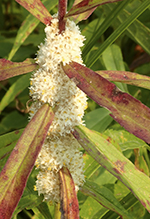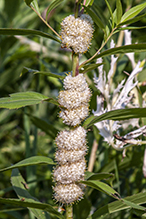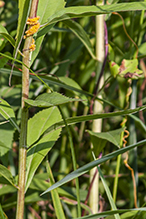rope dodder
(Cuscuta glomerata)
Conservation • Weed • Description • Habitat • Ecology • Use • Distribution • Taxonomy
Description |
||
Rope dodder is an annual herbaceous vine that parasitizes the above-ground portion of other plants. In the spring a seed produces a single, slender, fast-growing stem, and a single root. The root is for anchoring only. It does not absorb nutrients and withers away after the stem attaches to a host plant. The stem lives solely on the nutrients stored in the embryo. It must find and attach to a host plant in 5 to 10 days or it will die. It seeks a compatible host by detecting and growing toward specific airborne volatile organic compounds. When it encounters another plant it wraps around it. If the plant is a suitable host the dodder stem will produce sucker-like, specialized roots (haustoria) that penetrate and draw nutrients from the host plant’s tissue. As it continues to grow it becomes more robust and climbs the host, twining in a counter-clockwise spiral. The stems are wiry, branched, hairless, and yellowish-green, yellow, or orange. They are medium in diameter relative to other dodders but vary greatly in width, even on the same plant. They are mostly 1 ⁄64″ to 3 ⁄128″ (.4 to .6 mm) but may be up to 1 ⁄16″ (2 mm) in diameter. The stem sections between flower masses wither and fall away, often by flowering time. The leaves are alternate, stalkless, scale-like, and 1 ⁄32″ to ⅛″ long. There is usually a single leaf subtending each node. From May to early July rope dodder looks like orange tangled string. In July it produces flowers on parts of the stem that are tightly appressed. The inflorescence is a dense, rope-like mass of tiny flowers wound spirally around the stem of the host. The flowers are arranged in two parallel rows on opposite sides of the stem. Each flower is subtended by several overlapping modified leaves (bracts). These floral bracts are yellowish at first, lance-shaped, and completely enclose the nascent flower. They are sharply pointed, boat-shaped, and bent backward and downward at the tip. After a few weeks the bracts turn white, the stem withers and falls away between inflorescences, and the flowers emerge above the bracts. The flowers are stalkless and ⅛″ to 3 ⁄16″ long. They contain both male and female reproductive parts (perfect). They have 5 sepals, 5 petals, 5 stamens, and 2 styles. The sepals and petals are smooth, not hairy or bumpy. The sepals (calyx) are white and similar to the floral bracts but distinct, not fused together; sharply or bluntly pointed at the tip; and somewhat spreading at the tip but not bent backward. The petals are white, united at the base into a cylindrical corolla tube, and separated at the tip into 5 lobes. The lobes are shorter than the corolla tube, oblong to lance-shaped, sharply or bluntly pointed at the tip, and spreading or sometimes bent backward. The stamens are attached to the corolla tube below the lobes and are shorter than the lobes. They have white filaments and yellow anthers. Below each stamen a scale-like appendage (infrastaminal scale) is attached to the corolla tube. The infrastaminal scale is narrowly oval and densely fringed on the margin, profusely fringed at the top, less so along the sides. It is shorter than the corolla tube reaches the base of the filament. The anthers are about as long as or shorter than the filaments. The styles are slender; 3 ⁄64″ to ⅛″ long; distinct, not fused together; the same thickness throughout; and as long or longer than the ovary. At the tip of each style there is a head-like stigma. The stigma is not longer than thick. The fruit is a flattened, globe-shaped, about ⅛″ thick capsule that may be more or less pointed at one end. It has paper-thin walls, a thickened collar and withered remnants of the corolla at the tip, and dried sepals at the base. When ripe it breaks open irregularly, not on a transverse circular line. The seeds are light brown, oval, and 1 ⁄16″ to 5 ⁄64″long. |
||
Flower Color |
||
White |
||
Similar Species |
||
| The dense, rope-like inflorescence distinguishes this from all other dodders. | ||
Links |
||
There are excellent microscopic photos of the tiny flowers at Iowa Plants. |
||
Habitat and Hosts |
||
Moist or wet. Prairies, sedge meadows, fens, roadside ditches, stream banks. Mostly plants in the family Asteraceae, including Sunflower (Helianthus), goldenrod (Solidago), and ironweed (Vernonia), but also milkweed (Asclepias) and possibly mountain mint (Pycnanthemum). |
||
Ecology |
||
Flowering |
||
July through September |
||
Pests and Diseases |
||
|
||
Use |
||
|
||
Distribution |
||||
|
Sources |
|||
| 9/25/2022 | ||||
Nativity |
||||
Native |
||||
Occurrence |
||||
|
||||
Taxonomy |
|||
| Kingdom | Plantae (Plants) | ||
| Division | Tracheophyta (Vascular Plants) | ||
| Subdivision | Spermatophytina (Seed Plants) | ||
| Class | Magnoliopsida (Dicots) | ||
Order |
Solanales (nightshades, bindweeds, gooseweeds, and allies) | ||
Family |
Convolvulaceae (bindweed) | ||
Tribe |
Cuscuteae | ||
Genus |
Cuscuta (dodders) | ||
Subordinate Taxa |
|||
|
|||
Synonyms |
|||
|
|||
Common Names |
|||
cluster dodder clustered dodder rope dodder |
|||
Glossary
Bract
Modified leaf at the base of a flower stalk, flower cluster, or inflorescence.
Calyx
The group of outer floral leaves (sepals) below the petals, occasionally forming a tube.
Corolla
A collective name for all of the petals of a flower.
Filament
On plants: The thread-like stalk of a stamen which supports the anther. On Lepidoptera: One of a pair of long, thin, fleshy extensions extending from the thorax, and sometimes also from the abdomen, of a caterpillar.
Haustorium
In parasitic plants: a slender, root-like projection by which the plant connects to and obtains nutrients from tissue of the host plant. In fungi: specialized hyphae that penetrate and obtain nutrients from cells of a host. Plural: haustoria.
Perfect
Referring to a flower that has both male and female reproductive organs.
Scale
In plants, a small, usually flat and thin, modified leaf resembling the scale of a fish.
Sepal
An outer floral leaf, usually green but sometimes colored, at the base of a flower.
Stigma
In plants, the portion of the female part of the flower that is receptive to pollen. In Lepidoptera, an area of specialized scent scales on the forewing of some skippers, hairstreaks, and moths. In Odonata, a thickened, dark or opaque cell near the tip of the wing on the leading edge.
Twining
Growing in a spiral usually around a stem of another plant that serves as support.
Visitor Photos |
|||||
Share your photo of this plant. |
|||||
| This button not working for you? Simply email us at info@MinnesotaSeasons.com. Attach one or more photos and, if you like, a caption. |
|||||
Babette Kis |
|||||
Rope dodder, Cuscuta glomerata … rope dodder on Canada goldenrod, photographed on Barnes Prairie, Racine Co., WI Sept 3, 2017. I haven't seen it on the prairie since then, but could have missed it. |
 |
||||
MinnesotaSeasons.com Photos |
|||||
 |
 |
||||
 |
|||||

Slideshows |
||

Visitor Videos |
|||
Share your video of this plant. |
|||
| This button not working for you? Simply email us at info@MinnesotaSeasons.com. Attach a video, a YouTube link, or a cloud storage link. |
|||
Other Videos |
|||
| Parasite Dodder Time lapse Parasitic Plants francischeefilms |
|||
About
Published on Feb 27, 2015 Parasitic plants Dodder. Not all plants contain chlorophyll or possess leaves or even roots. There are always the exceptions to be found in the natural world. Dodder is such a parasitic plant. Able to obtain all of its food in order to reproduce, without the aid of doing anything other than sucking the life out of it's host, another plant. Like some crazy Sci Fi movie, the Dodder parasite merges with it's host where the Dodder's tissues are almost indistinguishable from the host tissue except for that trained eye.The only real plant like thing about Dodder is it's capacity to flower like normal flowering plants hence producing seed for the next generation. The Dodder's seeds are special too, they tend to germinate in the height of Summer and not spring. The small seedlings are able to withstand almost desiccating conditions which would kill all but cacti. This capacity for survival really gives this parasitic plant an advantage. Like many parasites, a common feature is that it doesn't kill its host but merely weakens it. Seed is almost microscopic and can be transported thousands of miles via unwary human or animal vectors. Although the Dodder can infect numerous plants from the smallest of small to entire trees in some instances, not all plants are susceptible. Plants can resist it's attack by producing compounds known as phytoalexins. Numerous species of Dodder are known. |
|||

Visitor Sightings |
|||||
Report a sighting of this plant. |
|||||
| This button not working for you? Simply email us at info@MinnesotaSeasons.com. Be sure to include a location. |
|||||
| Babette Kis 9/3/2017 |
Location: Barnes Prairie, Racine Co., WI … rope dodder on Canada goldenrod, photographed on Barnes Prairie, Racine Co., WI Sept 3, 2017. I haven't seen it on the prairie since then, but could have missed it. |
 |
|||
MinnesotaSeasons.com Sightings |
|||||

|
Created: Last Updated: © MinnesotaSeasons.com. All rights reserved. |
